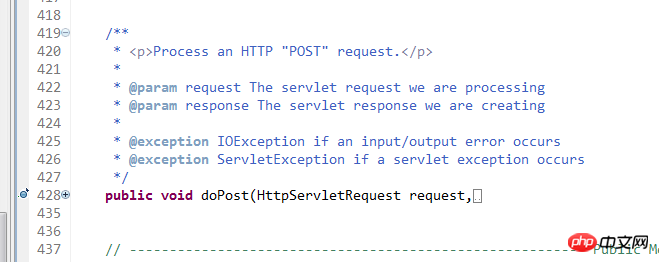这篇文章主要介绍了Struts1之url截取_动力节点Java学院整理的相关资料,需要的朋友可以参考下
Struts1之url截取
先我们来对ActionServlet深层次进行分析。我们用断点的调试的方式来看底层源码。因为这个实例是post方式提交,所以将断点设置到doPost方法上。

我们debug运行程序,进入doPost里面的方法:

这个方法非常重要是ActionServlet运行的核心方法。
我们进入这个方法:

再继续进入:

我们赫然发现了这样一个方法就是processPath方法,这个方法就是截取字符串的方法。这个方法的源代码如下:
/**
* <p>Identify and return the path component(from the request URI) that
* we will use to select an <code>ActionMapping</code> with which todispatch.
* If no such path can be identified,create an error response and return
* <code>null</code>.</p>
*
* @param request The servlet request weare processing
* @param response The servlet response weare creating
*
* @exception IOException if an input/outputerror occurs
*/
protectedString processPath(HttpServletRequest request,
HttpServletResponse response)
throws IOException {
String path = null;
// For prefix matching, match on the path info (if any)
path = (String) request.getAttribute(INCLUDE_PATH_INFO);
if (path == null) {
path = request.getPathInfo();
}
if ((path != null) && (path.length() > 0)) {
return (path);
}
// For extension matching, strip the module prefix and extension
path = (String) request.getAttribute(INCLUDE_SERVLET_PATH);
if (path == null) {
path = request.getServletPath();
}
String prefix = moduleConfig.getPrefix();
if (!path.startsWith(prefix)) {
String msg =getInternal().getMessage("processPath");
log.error(msg + " " + request.getRequestURI());
response.sendError(HttpServletResponse.SC_BAD_REQUEST, msg);
return null;
}
path = path.substring(prefix.length());
int slash = path.lastIndexOf("/");
int period = path.lastIndexOf(".");
if ((period >= 0) && (period >slash)) {
path = path.substring(0, period);
}
return (path);
}分析一下这段代码:
path = (String)request.getAttribute(INCLUDE_PATH_INFO);
if (path == null) {
path = request.getPathInfo();
}
if ((path != null) && (path.length() > 0)) {
return (path);
}这段代码首先判断一下javax.servlet.include.path_info是否存在路径信息,这里要知道当当一个页面是以RequestDispatcher.include方式显示的话,这个属性值才存在。所以这里没有值,就会进入path=request.getPathInfo()程序中,这里的getPathInfo获取的值是相对servlet的路径信息。
// For extension matching, stripthe module prefix and extension
path = (String) request.getAttribute(INCLUDE_SERVLET_PATH);
if (path == null) {
path = request.getServletPath();
}
String prefix = moduleConfig.getPrefix();
if (!path.startsWith(prefix)) {
String msg =getInternal().getMessage("processPath");
log.error(msg + " " + request.getRequestURI());
response.sendError(HttpServletResponse.SC_BAD_REQUEST, msg);
return null;
}这一段代码是判断javax.servlet.include.servlet_path是否存在值,这个也是当一个页面是以equestDispatcher.include方式显示的话,这个属性值才存在,所以这里的值没有。之后进入path = request.getServletPath();这个方法是获得返回请求URI上下文后的子串,所以这里的返回值就是“/”和访问页面名称和后缀(这里和我的mvc实例截取的是不是一样的道理)。随后进入下面代码:
path = path.substring(prefix.length());
intslash = path.lastIndexOf("/");
intperiod = path.lastIndexOf(".");
if((period >= 0) && (period > slash)) {
path = path.substring(0, period);
}
return (path); 这里的方法主要和我的上面的那里是一样的,主要就是去掉后缀。
以上是关于Struts1之url截取的详细介绍的详细内容。更多信息请关注PHP中文网其他相关文章!
 如何将Maven或Gradle用于高级Java项目管理,构建自动化和依赖性解决方案?Mar 17, 2025 pm 05:46 PM
如何将Maven或Gradle用于高级Java项目管理,构建自动化和依赖性解决方案?Mar 17, 2025 pm 05:46 PM本文讨论了使用Maven和Gradle进行Java项目管理,构建自动化和依赖性解决方案,以比较其方法和优化策略。
 如何使用适当的版本控制和依赖项管理创建和使用自定义Java库(JAR文件)?Mar 17, 2025 pm 05:45 PM
如何使用适当的版本控制和依赖项管理创建和使用自定义Java库(JAR文件)?Mar 17, 2025 pm 05:45 PM本文使用Maven和Gradle之类的工具讨论了具有适当的版本控制和依赖关系管理的自定义Java库(JAR文件)的创建和使用。
 如何使用咖啡因或Guava Cache等库在Java应用程序中实现多层缓存?Mar 17, 2025 pm 05:44 PM
如何使用咖啡因或Guava Cache等库在Java应用程序中实现多层缓存?Mar 17, 2025 pm 05:44 PM本文讨论了使用咖啡因和Guava缓存在Java中实施多层缓存以提高应用程序性能。它涵盖设置,集成和绩效优势,以及配置和驱逐政策管理最佳PRA
 如何将JPA(Java持久性API)用于具有高级功能(例如缓存和懒惰加载)的对象相关映射?Mar 17, 2025 pm 05:43 PM
如何将JPA(Java持久性API)用于具有高级功能(例如缓存和懒惰加载)的对象相关映射?Mar 17, 2025 pm 05:43 PM本文讨论了使用JPA进行对象相关映射,并具有高级功能,例如缓存和懒惰加载。它涵盖了设置,实体映射和优化性能的最佳实践,同时突出潜在的陷阱。[159个字符]
 Java的类负载机制如何起作用,包括不同的类载荷及其委托模型?Mar 17, 2025 pm 05:35 PM
Java的类负载机制如何起作用,包括不同的类载荷及其委托模型?Mar 17, 2025 pm 05:35 PMJava的类上载涉及使用带有引导,扩展程序和应用程序类负载器的分层系统加载,链接和初始化类。父代授权模型确保首先加载核心类别,从而影响自定义类LOA


热AI工具

Undresser.AI Undress
人工智能驱动的应用程序,用于创建逼真的裸体照片

AI Clothes Remover
用于从照片中去除衣服的在线人工智能工具。

Undress AI Tool
免费脱衣服图片

Clothoff.io
AI脱衣机

AI Hentai Generator
免费生成ai无尽的。

热门文章

热工具

EditPlus 中文破解版
体积小,语法高亮,不支持代码提示功能

WebStorm Mac版
好用的JavaScript开发工具

安全考试浏览器
Safe Exam Browser是一个安全的浏览器环境,用于安全地进行在线考试。该软件将任何计算机变成一个安全的工作站。它控制对任何实用工具的访问,并防止学生使用未经授权的资源。

SublimeText3 英文版
推荐:为Win版本,支持代码提示!

禅工作室 13.0.1
功能强大的PHP集成开发环境





